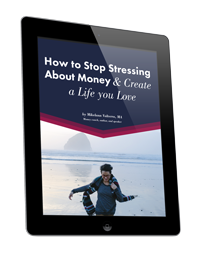 If you want to avoid that January spending hangover and December stress, find 15 minutes, a pad of paper and a cup of tea.
If you want to avoid that January spending hangover and December stress, find 15 minutes, a pad of paper and a cup of tea.
Remember, a plan lets you know when you’ve completed your shopping. It tells you when to stop — if you don’t have a finish line, you are going to keep shopping as long as the stores are open. (Or until the “guaranteed delivery dates” from online shopping move to December 26.) Knowing what you have already ordered and have left to buy — and how much more you want to spend– will save you a ton of money. You will finish your shopping earlier and you will have fewer impulse buys.
TIP: Create your plan in whatever form will be easiest for you to bring with you when you go shopping or sit at the computer. If you are a pen and paper person, use that. Keep everything on your phone? Make it digital. The best plan does you no good if you don’t bring it with you.
Make Three Columns
- First column: List People —Think of everyone you are planning on giving a gift to, and list them in the left column. Don’t put down gift ideas yet. Only brainstorm people, and make sure you get everyone. One of the biggest pitfalls is gifting a lot more people than we originally intended. Consider creating three sections: family, friends, and service providers (babysitter, hair stylist, etc.)
- First column: Now add other holiday expenses: after you list the people, write down: holiday cards (and photography?) holiday decorations, holiday clothes, holiday party costs and holiday travel.
- Second Column: List Gift ideas and other things that cost money — Now that you know who and what is on your list, write down gift ideas for people. And also write down the gifts you’ve already bought/ ordered. Write down holiday entertainment you are contemplating. (Going to see a holiday play? Need a new Christmas tree this year?)
- Three column: Money— Last, enter amounts of money in the final column. Do the best you can – a guess is better than nothing. If you have already purchased the gift, put down what you think you spent. Let me be clear- if the money has already left your account for ordered gifts, or gifts purchased long ago, list these amounts. Then list the amounts of money for gifts you have not purchased yet. What will the play tickets cost? The tree? Circle these unpurchased gift/ item numbers.
- Totaling Up and Adjusting — Now add up your total. If it includes gifts already purchased (back in August?) you may be surprised at the actual total. And then total up the remaining items to be bought- the numbers you circled. How do you feel about the amount? Does this seem reasonable? Really think about it. Can you afford this? Is it worth going into credit card debt to be able to give a gift to everyone you know? What are your other options? If your total plan seems too high, go back and make some adjustments and then re-total. Keep doing this until you feel better about the total.
- Tracking — As you spend money on the remaining gifts, jot down the amounts on your plan. Add up what you’ve spent on a weekly basis, or more if need be. Where are you? Remember, part of creating a plan is seeing what will happen before it happens! If you don’t like what you see, take the time to work on your list.
The good news is, trying to stick to a plan (regardless of how successful you are with it) will cut down on impulse buying, which is a major problem during the holidays. Without a plan, people buy more things and spend more money on each item they purchase. The temptations can be overwhelming when you are out shopping.
If you have gone through your plan and don’t know how to make this work, consider getting more creative. What if you changed your holiday gift-giving ritual? I used to give gifts to friends, but now we all go out and enjoy a play together. This came out of doing my own first holiday spending plan. I felt a little guilty when I approached them with my idea, but discovered they were all relieved.
My colleague Karen McCall wrote an amazing post on how to have a joyous and debt-free holiday. She covers not only how to do a holiday spending plan, but also helps you examine your feelings and beliefs about the season to see how they impact your behavior. Check it out: The 10-Step Plan to Have a Joyous and Debt-Free Holiday Season (financialrecovery.com)
And last, a final quote for you from Dr. Seuss: “Maybe Christmas, the Grinch thought, doesn’t come from a store.”
I wish you joy,
Mikelann

